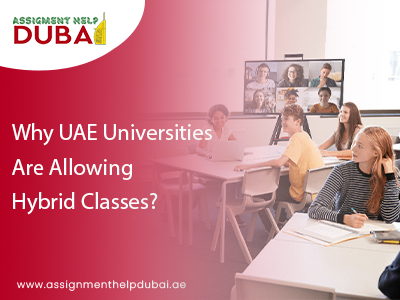The UAE universities are responding to the ever-changing education landscape. And the constant challenges of the COVID-19 pandemic by adopting hybrid classes. These are a combination of face-to-face and online instruction as a flexible and resilient approach to teaching and learning.
This transformation is a result of a strategic approach. Which aims to use the technology appropriately, and suit the different needs of the students. And make sure that students are learning consistently and spontaneously in an ever-changing environment.
1. Hence, Adaptability To The Changing Conditions Becomes Critical
The COVID-19 pandemic of 2020 has set the precedent in making educators more adaptable. And yielding high levels of resilience in teaching. Through the hybrid classes model, the UAE universities prove that they can deal with modern circumstances.
And the unforeseen incidents of disruption of the conventional ways of learning. Whether the schools are temporarily closed, travel is restricted or there are health issues, the hybrid model allows universities to continue instruction. At the same time, students’ academic progress is not interrupted.
2. An Advance In The Flexibility Of Students’ Curriculum
Hybrid classes are now adapted, in a way, by the learners especially when managing their academic load. By the way of providing a choice of in-person and online lessons, universities give a variety of learning styles and personal situations to meet. Students can also enjoy remote learning.
Here they can attend classes even though they are not on campus. Thus, they can achieve academic goals amid other personal life obligations such as work. It is more convenient for the enlightenment of non-traditional, working professionals. And those with family obligations, as it helps them not to be overburdened with additional obligations besides their education.
3. Opportunity To Study A Wider Range Of Classes
This means that students not in the proximity will benefit from the availability of classes and the challenge of distance and time. This wider accessibility of educational opportunities expands the opportunities for the students living in the villages, international students.
And also those who are physically not very active. Complementing that, the blending offers an opportunity to vary the module se. And attract students from all sorts of backgrounds. Hence supplying a mixed academic experience to everyone.
4. The Integration Of Technology & Innovation Is More Than Simply Applying Technology & Promoting Innovation
Hybrid classes harness the technology to make the learning process more interactive and engaging. Learning platforms in virtual space, multimedia resources. Such tools as collaborative ones represent not only elements of motivation for a student but also leave a large space for active participation in both synchronous and asynchronous activities.
The assimilation of technology in the educational landscape of the UAE displays the universities’ attraction to innovation. And creating a competent workforce to meet the challenges of a future digital world. Besides, the use of digital tools helps to build digital literacy skills. And create a culture of lifelong learning among students and faculty.
5. Rationalized Physical Resources
The online feature of the hybrid course enables the university to make the best use of the physical infrastructure, preventing the classrooms from being vacant and their maintenance expenses being preserved. Of all, through this optimization, resource utilization is improved.
These together with the sustainability brought in by a lower carbon emission, given that commuting and campus activities generate carbon emissions.
6. Faculty Professional Hone Event Development & Educational Pedagogy
The conversion to hybrid classes is a chance for teachers to grow professionally. And to be creative in terms of instruction. Educators can take advantage of this opportunity to practice different teaching methods and experiment with creative instructional techniques. And identify their diverse approaches to come out with effective teaching.
Universities provide workshops and partner training. And a network of relationships to improve their digital literacy, and the application of technology to promote learning. This investment in faculty development leads to the quality of education quality.
This encourages excellence in teaching and learning. Students have the facility to opt for online helpful assistance such as University Assignment Help for their convenience and further guidance.
Conclusion:
The use of a blended learning model which is usually referred to as “hybrid classes” in UAE universities is just a way to be up to date and always implement the new ways of education that are based on adaptability, flexibility, and innovativeness.
Being an integral part of the educational landscape that is constantly changing, hybrid classes are proof of the strength and flexibility of UAE universities in facing challenges. And also in creating the future of higher education.
Thanks to purposeful planning, technological investment, and networking among the interest groups, UAE universities are becoming the top learning institutions. These are providing high-quality, affordable, and creative education to students from around the globe.

